

|
Back to |
| The Front Page |
| Letters & Opinion |
|
Timing is everything (a response to the editorial "The bugaboo of time") words and most photos by Bert Myer layout by Reuben Edwards posted December 30, 2015
|
||||||
|
||||||
Bert Myer has responded to our recent editorial on the negative influence of clocks in American Rules and Association Croquet. Myer always writes well, especially in defense of his own opinionations, and most of these are concentrated on American Rules play. The "fairness" of top-level results in every country and under every code is considered in the Alman editorial, which also outlines prescriptions for guaranteeing the interactivity intended to allow the most gifted players to emerge at the end of an untimed but limited series of games or matches played to the peg. The editor would welcome a response equivalent to Myer's from an international writer on Association Croquet competition at all levels of play.
Oh, come on now. Time is of the essence!
The vast majority of players, let alone spectators, has no time for interminable day-long matches or best-of-5 or best-of-100, or 10-day endurance tests conceived to finally, tediously, determine once and for all (time) who is truly the best of the best--not just lucky, not just a one-time wonder with a single brilliant performance, not just a cagey manipulator of time. No.
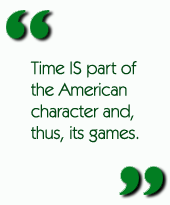
What is being advocated in the editorial, "Time is a cruel master" (Croquet World Online) is that the best shooter, strategist, split-shot maven, pass-roll king, most skilled break player, hit-in dead-eye, can only emerge, ultimately, at long last, through countless mano-a-manos--while the rest of the pretenders get weeded out, through, well, the test of time!
I beg to differ. Time IS part of the American character and, thus, its games. Even baseball, once a timeless pastime, is now testing a "pitch clock" in the minor leagues to speed up games--and avoid 17 inning marathons that go on into the wee hours to decide what? Who was best that day? Or who had the most pitchers still able to throw a ball?
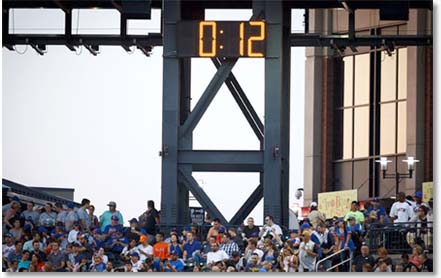
|
| Until recently, time has never mattered in baseball. Nowadays, to speed up games and maintain fan interest, professional baseball is experimenting with a "pitch clock." Photo byRichard Perry, New York Times.] |
Professional golfers who linger are "put on the clock" to keep things moving. Even non-professional rounds are prodded along by course rangers, if not anxious foursomes waiting behind them on the tee or fairway.
Basketball, football, even hockey (there are "delay of the game" penalties for infractions that interfere with flow of the game) are all time-honored events. Soccer? Well, there is "extra time" added to the timed matches and, maybe (at long last) a shoot-out to break the inevitable scoreless tie.
A shot-clock is integral to Chess. Perhaps only bowling and tennis are timeless, although long service dilly-dallying in racquet sports can be punished.
The Australian Tony Hall may have burst out laughing at the American culture he witnessed manifested in a closely timed American Rules game long ago in San Francisco, but the other side of the coin can seem equally ridiculous.
I recall an incident of my own on a trip to New Zealand around the same time, in the late 1980s. I happened upon the croquet courts at Government Gardens in Rotorua on the North Island. I had only a passing knowledge of Association croquet, but a nice chap asked me if I wanted to play a game, and I said, "Sure." He lent me a mallet and we played for an hour or so, then he suddenly said to me, "I'm off to lunch now. Be back soon." He leaned his mallet on a wicket and strolled off without another word. I found THAT to be absurd. I didn't stick around.
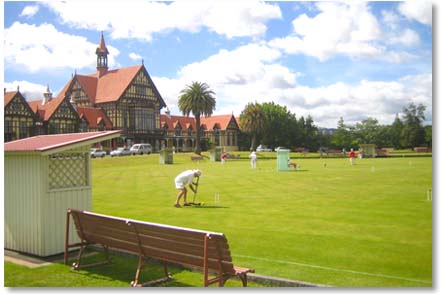
|
| Government Gardens in Rotorua, New Zealand has multiple croquet courts and lawn bowling facilities on its sprawling lawns. I played a pick-up game there in 1987 with a nice chap who thought nothing of wandering off to lunch well before our match had concluded. Time in Association Laws Croquet apparently didn't matter.] |
My American roots in croquet time
Since 1960, I have been playing unfailingly in a 3-day Labor Day Weekend 9-wicket backyard mixed doubles croquet tournament which consistently attracts 60 to 80 or more players ranging in age from 16 (minimum) to quite ancient (which sometimes is a cause of slow play). This is "my roots" in croquet and, while I have thoroughly embraced American 6-wicket rules croquet for more than three decades, I return enthusiastically to this event each year.
I cite this because the rules, established in 1950 and only slightly modified since, are an interesting amalgamation of classic American backyard "adaptive" local rules, USCA conventions, and Association Laws gleaned, well, from somewhere. But "time" is what is important here, and what has remained unchanged for 65 years.
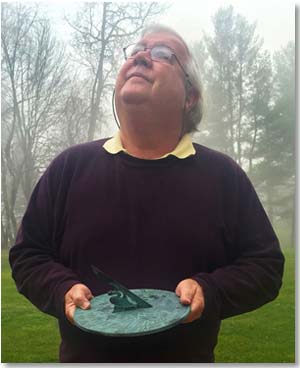
|
| Bert Myer of Stratham, New Hampshire, considers the utility of an ancient time-honored solar-powered device given him by the district croquet association in celebration of the completion of a regulation-size croquet court in his back yard.] |
The format is a single-elimination ladder. Lose and you're out. The first several rounds of matches are one hour long and end promptly when the timer rings. There are no "last turns." If the match is tied, whichever team scores a wicket next wins.
The most vociferous complaints, the most angst, the majority of the discussions in pre- and post-tournament oversight committee deliberations, and at the tournament's nightly cocktail parties, have to do with players taking too much time discussing their next move. There are no shot clocks and there is no particular assumption about what's a reasonable amount of time for strategy sessions or coaching or helping a partner line up a crucial shot. Some players deliberately stall; others are oblivious; most eventually do something when their turn comes around, ready or not. The vast differences in experience levels (and age and abilities) in this once-a-year event contribute to this dilemma, but no adequate solution--other than "officials," when available, being encouraged to remind offending players: "It is a timed match; please be fair"--has ever been adopted. (It is, after all, a social event. Well, most of the time.) In the quarter-final and semi-final games, the match time limits are 90 minutes. Then, for the final, magically, there is no time limit at all. First team to peg out wins.
American cultural impatience, however, has intruded on this tradition over the last decade or so. The final used to be scheduled for late Monday afternoon of the holiday weekend, and a pleasant picnic followed on a nearby beach around a bonfire. Nowadays, the younger people have to get on their way to sports practices and college classes, others simply have to rush back home to prepare their busy households for the upcoming school or work week. Many of the older people, often resident hosts, have had enough of croquet after two days. So, the final is the only match scheduled on Monday. It begins at 11, and hopefully ends quickly, in time for a late lunch. It still attracts a big crowd, but there is mounting pressure to introduce a time limit, since the spectators tend to get antsy, or bored. Or hungry.
I suspect the original thinking of the founders of this event was that an untimed match between the two surviving teams was the only "fair" way to determine the weekend champion. Of course, the paradox is that both teams made the final because they managed to win all of their timed matches along the way. I suspect that eventually the demands of modern day living will prevail and, alas, even the final will be limited, maybe to a generous two hours, but most likely less. Time is, after all, a luxury--and not to be squandered.

|
| I play in a Labor Day Weekend, 9-wicket backyard croquet tournament that has been using strict match time limits --except in the final--for 65 years. However, there is mounting pressure to impose a time limit in the final because of the demands of modern day living.] |
The luxury of uninterrupted play on a private court
From the late 1980s until well into the 2000s I maintained a regulation-size, championship caliber court on my property in New Hampshire. We played mostly American Rules 6-wicket croquet, and most of our pick up games, including occasional weekend-long extravaganzas with other serious players and friends were, since we had time, played to the peg, with no time limits. It was just what we did and it was fun.
However, all our invitational, state, club, and inter-club tournaments--most of them USCA sanctioned--had 75- or 80-minute time limits and 45-second shot clocks. It was universally accepted that this was the way tournament games were played, and nobody ever suggested otherwise.
Perhaps the paucity of Association Laws players in the area contributed to our parochial attitude, but we had way more players than courts and only so many hours in a day. We adapted readily to the added pressure of title event play, and that was without doubt one of its key attractions. The jangled nerves and tension induced by the unforgiving, ticking clock brought real highs. And devastating lows. But, if you were to ask any of our group--once a very large and significant portion of the New England croquet scene--to adopt no-time-limit games at, say, the Regionals or Nationals, the response would probably be: "That's a whole different game." And it is.

|
| At my croquet court in Hampstead, New Hampshire, we played most of our 6-wicket pick-up games "to the peg"--with no time limits. Of course, we had plenty of time and did not have to share the court with others. For tournaments, though, scheduling necessitated match times--which most players found to be an attractive added dimension.] |
What's fair? What's the game?
Wait just a minute: Who's to say what's fair and what constitutes "croquet"? One version of American 6-wicket Rules calls for timed matches and one round of last turns, and pays lip service to a 45-second shot clock. Those are the well established parameters, and they're just as legitimate from a historical perspective as any other form of the game.

I used to debate the late Jerry Stark about this. He thought of himself as a purist, maintaining that "real croquet" should be played to the stake or, at the very least, that wicket count was the true measure of the best player, if and when matches were timed. I took the position that with rules the way they were, defeating one's opponent was the most important thing--that 26-2, 20-19, 10-8 or 3-2 were all the same. To me, it was equally virtuous to win 6-5 (and not go through 1-back) as pegging out, although the latter may indeed be a nice way to win. Winning was the goal — and what ultimately mattered. Time was simply an extra strategic factor, not an aberrant.
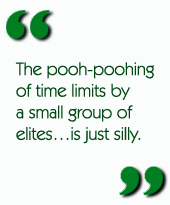
Also, consider the plausible assumption that American Rules croquet is the dominant game in one of the largest croquet-playing countries and, arguably, played by the largest number of people. The pooh-poohing of time limits by a small group of elites who seem to think that day-long, best-of-X matches featuring 26-0 scores and/or sextuple peels are nirvana on grass is just silly. And really unimaginative, despite the skill involved.
If it was tradition that perpetuated slavery (quite a metaphorical reach in Bob Alman's article, I must say), is it not a similar attitude which desperately seeks to protect a version of croquet increasingly out-of-step with modern times?
Managing time is a critical part of the American game. Keeping an eye on the clock, using the clock--they're as much a part of American 6-wicket croquet as the deadness board and 9-inch boundaries. If you choose to play under a different set of rules, fine, go ahead. Adapt accordingly. Have a seat, get comfortable, and don't complain if your opponent trots off to lunch between shots.
Time marches on.
Bert Myer has been a member of the United States Croquet Association since 1982, when he founded a club based at his home in southern New Hampshire. He built and maintained there a regulation-size, bent grass court where, from the late 80s until well into the 2000s, he and his wife hosted USCA-sanctioned local, state, inter-club, and invitational tournaments and teaching clinics. He has served on the USCA management committee as New Hampshire District President and New England Regional Vice President, and on many USCA sub-committees. He was the editor and principal photographer for four editions of the coffee-table style magazine, USCA Croquet Annual (1992-1995), and for several years was the editor of the bi-monthly USCA newsletter. He also was coach of the Harvard University croquet team, national collegiate champions in 1992. He has written about croquet and provided photographs of its players, venues, and events for national and regional consumer and specialty magazines, and has contributed to many USCA print, video, and Web projects, including Croquet World Online. He is a Class 1 referee, and currently holds a 1-1/2 handicap. Although his pen has proven mightier than his mallet over the past 30 years, Bert has won his share of national, regional and invitational tournament titles, and has participated in competitions at most major croquet venues in the United States, Canada, and Bermuda.